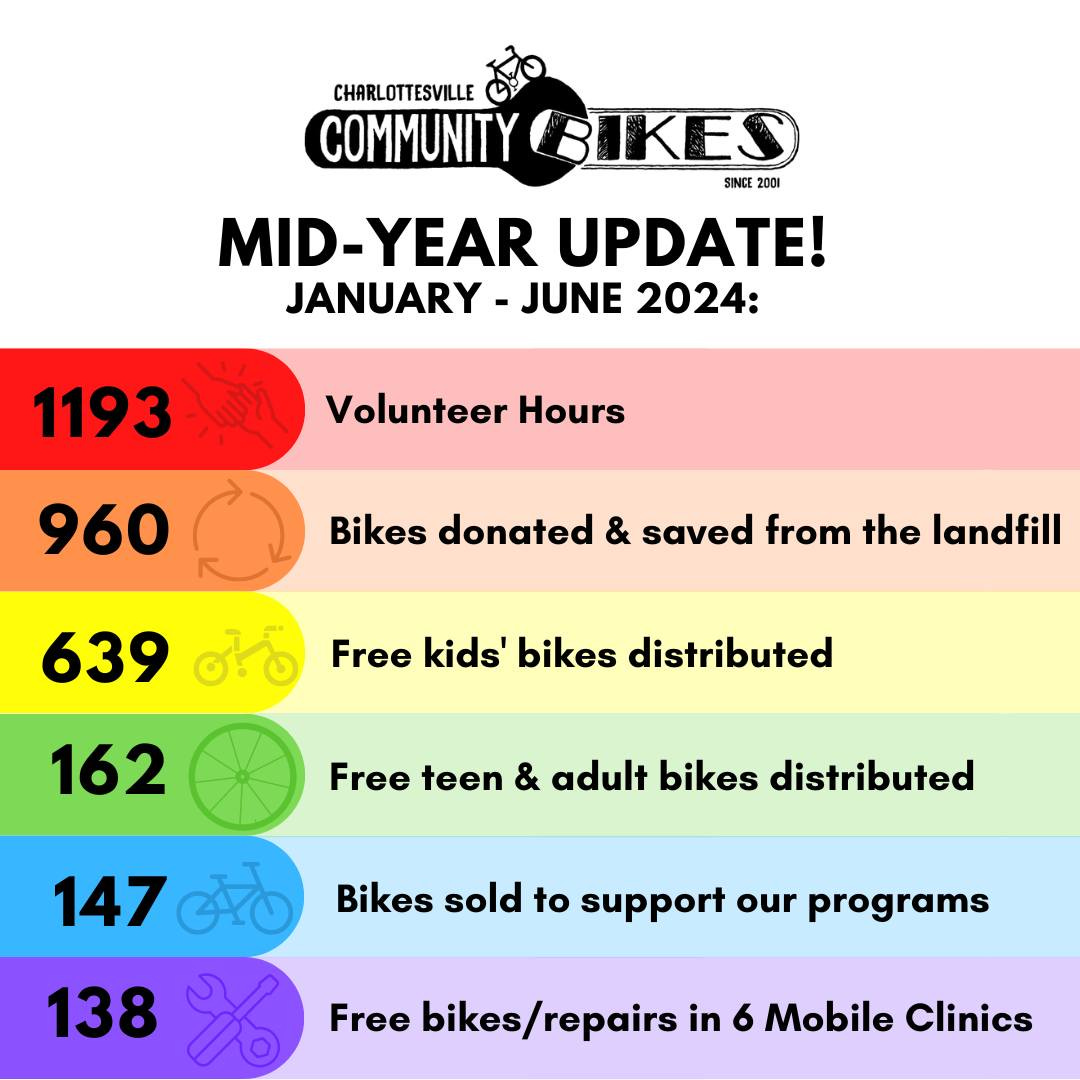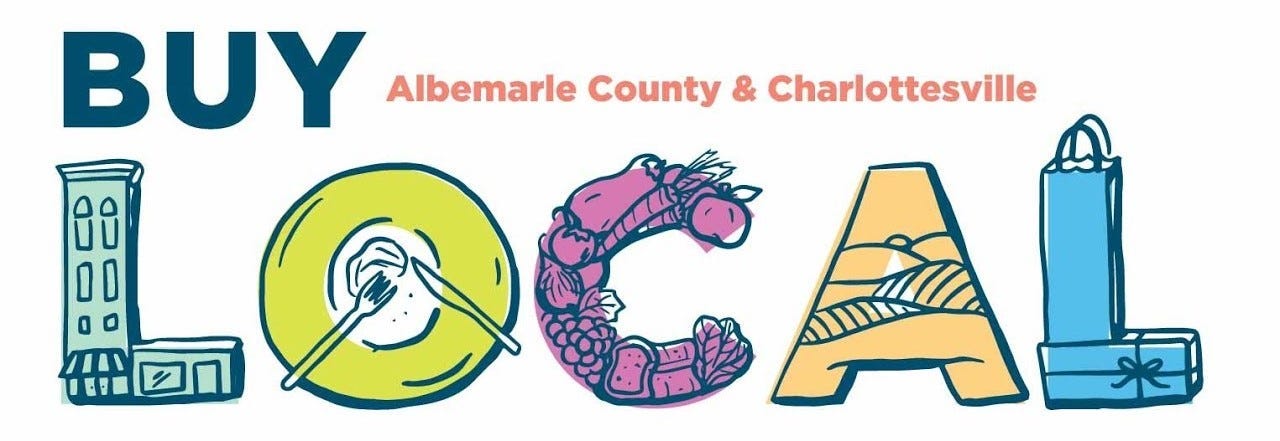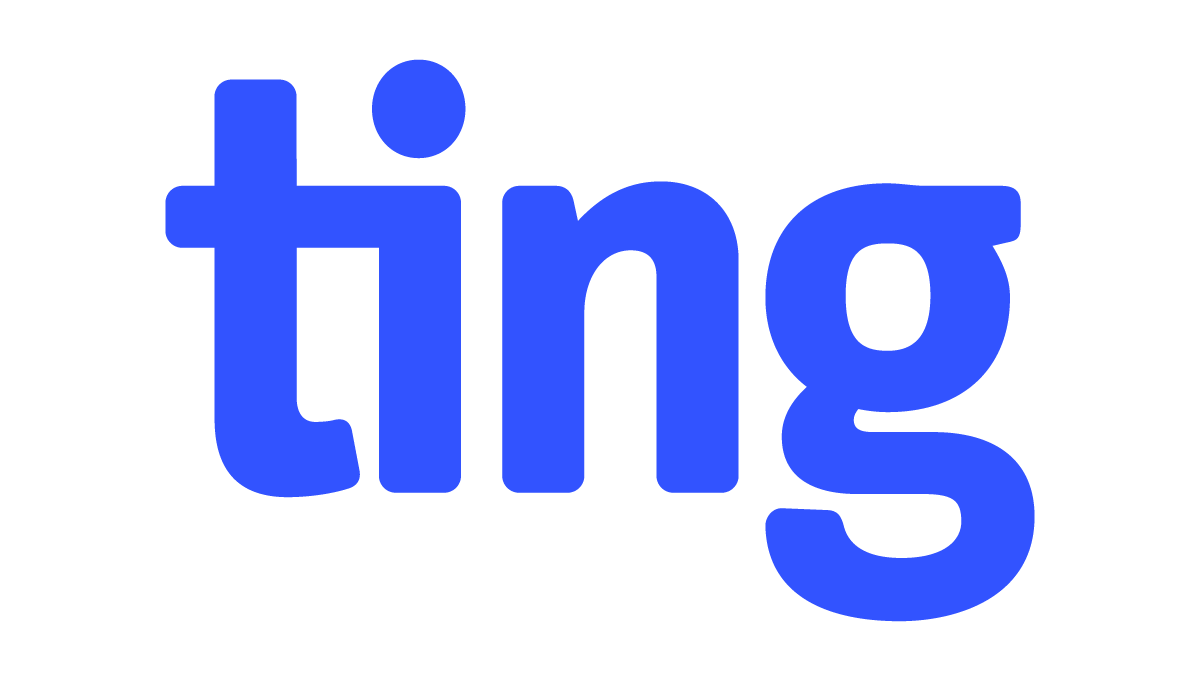July 10, 2024: Dominion to study feasibility of small modular nuclear reactor at North Anna Power Station; Recent legislation allows company to charge ratepayers for early development costs
Plus: A look at cell use policies at area school systems now that Governor Youngkin has issued order seeking to ban them in public schools
Today in 1923, Earl Hamner was born in Schuyler, Virginia about 20 miles southwest of Charlottesville. Hamner created the long-running television program The Walton’s. Like much pop culture from the 20th century, the relevance of the show has perhaps faded with time. But the show depicted life in a Blue Ridge community not unlike the one in Nelson County where Hamner grew up.
Who will write the stories of how we interact now so that people fifty years from now might know what it was like? That’s the sort of rhetorical question that often opens an edition of Charlottesville Community Engagement. I’m Sean Tubbs, prone to mistakes.
In today’s installment:
Charlottesville police detectives seek more evidence on the pedestrian fatality on Nassau Street this past weekend
Dominion Energy announces it will seek to build a modular nuclear reactor at Lake Anna and ratepayers may pay for early development costs
Governor Glenn Youngkin issues an order seeking to ban cell phone in public schools
The federal government has opened up a third round of highway transportation funds for projects to reconnect communities
Albemarle County publishes a transportation dashboard intended to increase awareness of current, future, and recently completed projects
Fairfax County will receive $50.6 million to purchase diesel-electric hybrid buses
First shout-out: Community Bikes on track for a successful 2024
In today’s first subscriber-supported shout-out: Charlottesville Community Bikes does a lot to help everyone who wants a pedal-fueled vehicle to get one. They also keep track of their impact on the community. This week on Instagram, Charlottesville Community Bikes posted their report for the first half of the year and so far this year they’ve handed out 639 free bikes to kids and 162 to teens and adults!
Charlottesville Community Bikes will be closed for the holiday and through the weekend to allow staff to recharge. Visit communitybikes.org to learn more about the organization and to find out how you can add to the 1,193 volunteer hours so far this year!
Charlottesville Police seek witnesses in Nassau Street fatality
The Charlottesville Police Department and the Commonwealth’s Attorney office are asking the public’s help to obtain more information in their investigation of what led to an unnamed woman allegedly fatally hitting a Charlottesville man with her car on Nassau Street Saturday evening.
“Through the course of this investigation, we have been made aware of community members who have yet to come forward to speak with detectives but claim to have knowledge of this incident,” reads a press release sent out at 11:54 a.m. this morning. “While our detectives will continue to work tirelessly to ensure a thorough investigation is completed, we are also calling on community members to come forward.”
Police were called to the 700 block of Nassau Street Belmont-Carlton neighborhood on Saturday evening were they encountered 42-year-old Edward Fitzhugh Anderson who was pronounced dead on the scene. The driver of the car that him was on scene and claimed she was attacked but that she did know Anderson.
Several people have disputed this version of events on social media and in press accounts but those cannot be used in an official investigation. Now police want people with any evidence or information to come forward.
“It is vital for a full and complete investigation that all avenues of the investigation are vigorously pursued,” the release continues.
Anonymous calls are welcomed at 434-977-4000.
Dominion seeks proposals to explore feasibility of a small nuclear reactor at Lake Anna
Legislation signed by Governor Glenn Youngkin earlier this year will make it easier for energy producers to recoup the costs of building a “small modular nuclear facility” that generates less than 500 megawatts.
Today, Youngkin traveled to Louisa County to be on hand as Dominion Energy Virginia announced they are seeking proposals from companies that develop small modular reactors (SMR) to determine if it would be cost-effective to build one at the company’s existing facility at North Anna.
"As Virginia's need for reliable and clean power grows, SMRs could play a pivotal role in an 'all-of-the-above' approach to our energy future,” said Dominion Energy president and CEO Robert Blue. “Along with offshore wind, solar and battery storage, SMRs have the potential to be an important part of Virginia's growing clean energy mix."
Blue is also a member of the University of Virginia Board of Visitors.
According to a press release from Dominion, SMR technology can generate energy “with a significantly smaller footprint and lower upfront capital costs.” For many years, the company has explored building a third reactor at North Anna and received a permit from the Nuclear Regulatory Commission in June 2017. (see the details)

Youngkin was at today’s event to symbolically sign legislation that allows Dominion to petition the State Corporation Commission to adjust its rates to cover the costs of early development for an SMR.
“The legislation contains cost caps limiting current SMR development cost recovery to no more than $1.40 per month for a typical residential customer,” reads a press release from Dominion Energy. “The company anticipates that its initial request will be substantially below that limit.”
SB454 initially passed the Senate 20 to 16 and an amended version passed the House of Delegates 52 to 44 with one abstention. Youngkin made recommendations to lower that cap from $1.75 to $1.40 per month. Those were agreed to in a 68 to 27 vote in favor with one abstention.
The Youngkin administration argued that one reason to leave the Regional Greenhouse Gas Initiative was due to Dominion and other providers adjusting their rates to cover the cost of participating in auctions for the right to exceed emission caps.
While much of the conversation about SMR technology has focused on building them in southwest Virginia, a fact-sheet provided at the announcement explains why one at North Anna makes sense to Dominion.
“Siting SMRs on an existing power station property, such as at North Anna, allows for interconnection to the grid and access to necessary and available workforce,” reads the fact-sheet.
In their information release, Dominion states that the issuance of the request for proposals does not mean this proposed new unit would be built, but such power generation would be consistent with their latest Integrated Resource Plan. (view the document)
For more information on the legislation, take a look at Charlie Paullin’s February 14, 2024 story on the Virginia Mercury.
In related news, Dominion Energy announced on Monday that its Virginia Electric Power subsidiary will purchase a 40,000 acre lease for wind energy from the company Avangrid. They’ll pay $3,000 per acre for a total of about $160 million.
The project is still not approved by regulators but could generate 800 megawatts.
"With electric demand in our Virginia territory projected to double in the next 13 years, Dominion Energy is securing access to power generation resources that ensure we continue to provide the reliable, affordable, and increasingly clean energy that powers our customers every day,” Blue said in a different press release.
The project will be a counterpart to Dominion’s Coastal Virginia Offshore Wind (CVOW) project which is currently under construction. One remaining issue with that 2.6 gigawatt project is how it will connect to the shore.
“The company is aware of the community concerns regarding the proposed landing site in Sandbridge, Va., and is committed to working closely with the community, the Commonwealth of Virginia, and the City of Virginia Beach as it considers this project,” reads that second press release.
Governor Youngkin issues order to ban cell phones in public school
Public school systems across Virginia will soon have to demonstrate how they will enforce a ban on students having cell phones in the classroom.
Governor Glenn Youngkin issued Executive Order #33 yesterday directing multiple department heads across the state government to come up with policies for how schools will implement the prohibition of what has become a ubiquitous part of American life.
“Parents, public health professionals, educators, and other stakeholders across the Commonwealth are expressing concern over the alarming mental health crisis and chronic health conditions affecting adolescents, such as depression and anxiety, driven in part by extensive social media usage and widespread cell phone possession among children,” reads the order.
The order notes that many school divisions in Virginia have policies in place to restrict usage whereas others leave it up to individual teachers.
“Clear guidance provided by the Virginia Department of Education will significantly benefit students, parents, and educators, while assisting local school boards and divisions in considering the appropriate response in mental health and educational problem,” the order continues.
There are eight specific directives for the Secretary of Health and Human Resources, the Superintendent of Public Instruction, and the State Health Commissioner to take on. The second requires the establishment of a definition of what “cell phone-free education” would mean.
The fourth would require publication of guidelines for policies and procedures by August 15, 2024. The fifth would require rules for how parents can communicate with children during the day as well as carve out exceptions for students with medical needs who may need access to phones for emergencies.
School divisions have until January 1, 2025 to comply. There are no suggested punishments.
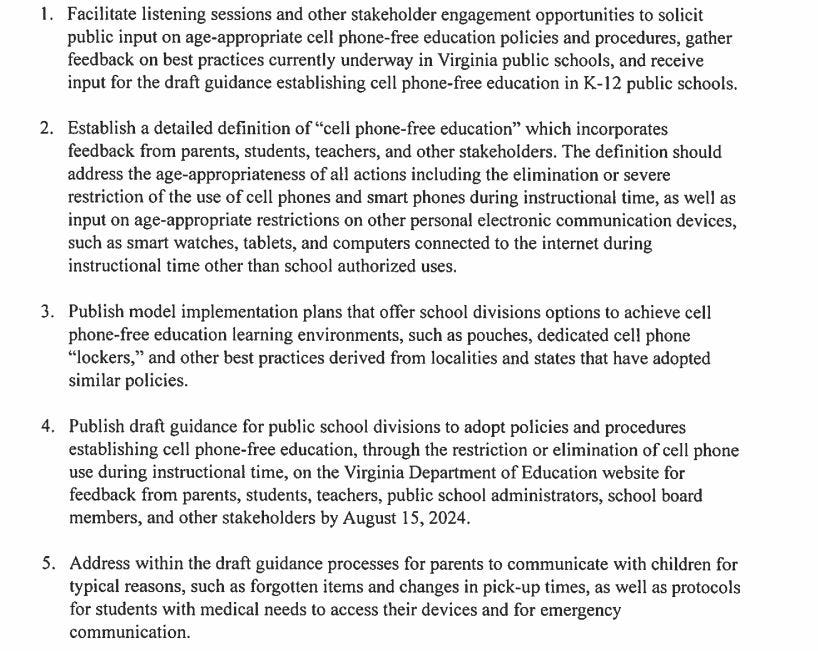
What are the policies in place in this area?
Albemarle County Public Schools have a policy for middle school students that require cell phones to be put away for the day between 9 a.m. and 4:05 p.m. In high school, cell phones is prohibited during class and the devices must remain out of sight. However, they may be used between classes and at lunch. (review policies)
Charlottesville City Schools instituted a policy last year that phones be “off and away the entire day” and the system began piloting the use of “Yondr pouches” this past academic year. The last update on their website is from last August. (review policies)
Fluvanna County Public Schools also ban the use of devices during class, and they must be put away during the day. Unfiltered internet connections are not allowed and communication with family members is not allowed without permission. (review parent’s guide)
Greene County Public Schools have a similar policy to the one in Fluvanna that allows possession but not use during instructional time unless a teacher allows it to be used for instructional purchases. Unfiltered internet is also now allowed. (Greene County handbook)
Louisa County Public School devotes a paragraph to communication devices in their Code of Conduct if they are “off and out of sight during the school day except for authorized use.” They are also not to be used on school buses unless the driver gives permission. (Code of Conduct)
The Code of Conduct for Nelson County Public Schools uses the phrase “off and out of sight during the instruction time” but refers parents to each school for more specific rules for each one. Use on buses is okay, but at no point can the devices be used to film anything. (read the Code of Conduct)
What do you think?

Sponsored message: Buy Local
Buying locally supports our neighbors and community members and makes a big impact for our local economy. Local businesses are more likely to reinvest in our community and their goods and services contribute to the unique character of our community.
Learn more about how you can support local business at ShowLocalLove.org and on social media:
Federal government taking applications for Reconnecting Communities grant
There has been an infusion of funding for transportation projects from the federal government in the last few years with the Infrastructure Investment and Jobs Act in November 2021. That legislation signed by President Biden is also known as the Bipartisan Infrastructure Law.
One related funding opportunity that comes from the Federal Highway Administration is called Reconnecting Communities and the idea is “to help revitalize and reconnect communities cut off from opportunity by past transportation infrastructure decisions.”
Albemarle County has twice applied for funding through this program for a study of how to abate the effects of an eight-lane highway that cuts through Albemarle County’s growth area. That is the outcome of a long history of competing sides on whether to build a bypass to carry vehicles around the commercial area.
So far, Albemarle has so far not been among the 176 communities across the nation that have received a total of $3.3 billion in funding. The county asked for $300,000 for a planning grant and had the support of the City of Charlottesville. (read my story)
In the second round, the program received a total of $11.6 billion in requests from 682 applications. Ninety-seven percent of the awards went to projects in communities considered to be disadvantaged. Successful projects appear to be in cities where highways replaced intact communities.
“Due to prejudicial housing practices of the time, the communities that received the brunt of these decisions were often African American,” reads a StoryMap produced as part of the program. “Thousands of families were forcibly displaced, many without proper compensation, to erect loud, dangerous concrete barriers in the middle of neighborhoods.”
For instance, the city of Atlanta has been awarded over $157.6 million to complete the first phase of a project called the Stitch. That’s will replace sections of I-75 and I-85 with a four-acre park, rehabilitation of a transit station, and local street improvements. (learn more)
“These improvements will reconnect the street grid of Downtown Atlanta, which was disrupted by the construction of the interstates in the 1960s,” the StoryMap continues.
There is about $600 million in funding for the third round with $457 million for capital construction and $150 million available in planning grants.
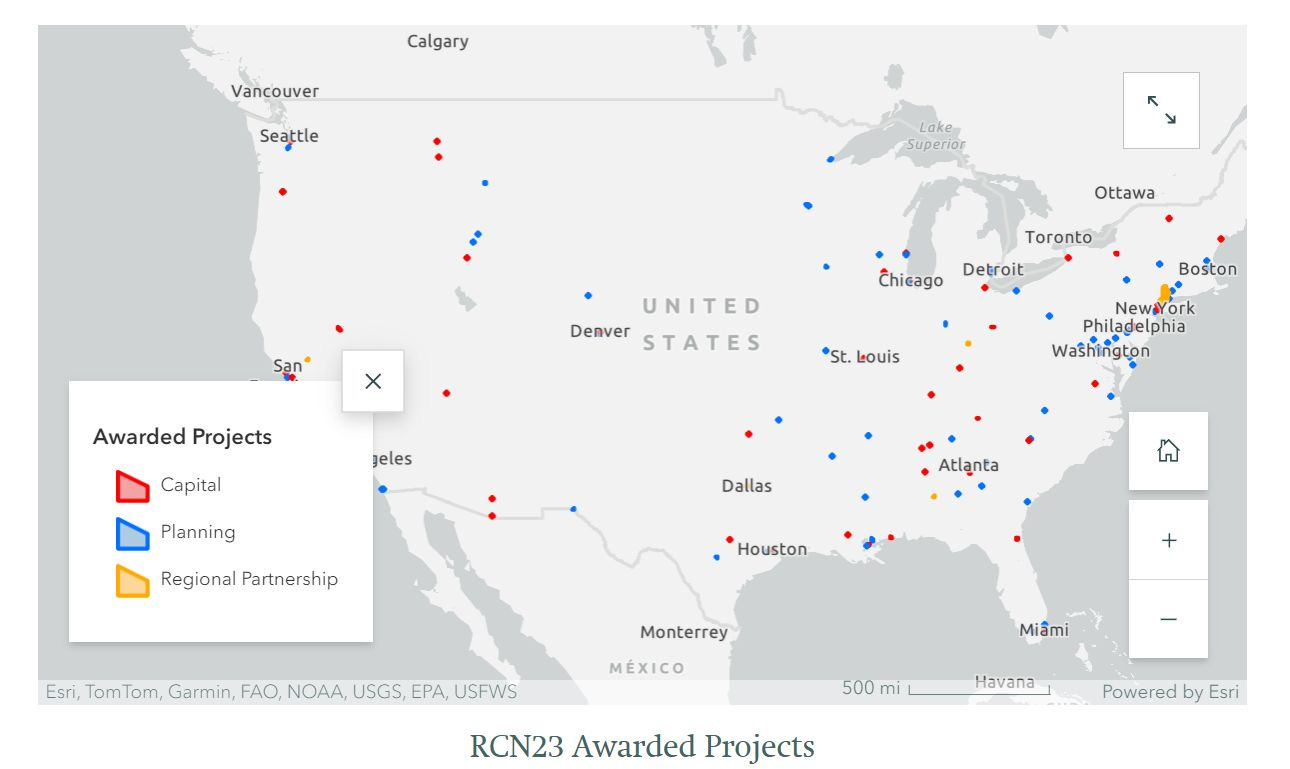
Albemarle launches transportation dashboard to track information
Federal grant programs are not the only way transportation projects are funded. Anyone driving on U.S. 29 this week can see projects underway such as the conversion of a traffic signal at Hydraulic Road and Hillsdale Drive with a roundabout. There’s a detour in place through mid-August.
But what else is happening and what else is planned? To assist the public, Albemarle County has recently announced the creation of a new portal to get answers and information.
“The Transportation Project Dashboard shows recently completed, under construction, and in design transportation as of 05/01/2024,” reads the website for the new service which is to be updated quarterly.
Visitors to this portal can look up projects on a map or on lists of either “points” or “segments.” The current project at Hydraulic is listed as under construction and lists the full scope as:
“Removing left turns from Hydraulic onto US 29; construction of a roundabout at Hillsdale/Hydraulic, Pedestrian Bridge over US 29.”
There’s also a link to the project documents which takes you to the Virginia Department of Transportation’s website. One item not listed in Albemarle’s dashboard is the cost of projects, but intrepid information seekers can look that up on VDOT’s Six Year Improvement Plan page.
Segments are projects that will happen over a linear span. Several are in design such as the extension of Berkmar Drive to Airport Road, sidewalks on the southern side of Commonwealth Drive, and bike lanes and sidewalks on Old Lynchburg Road from Timberland to Azalea Park.
The portal does not include projects for which the county or other entities have not been awarded funding through Smart Scale or some other funding mechanism. For instance, the Charlottesville-
The transportation dashboard now accompanies a similar one for residential and commercial construction projects. The Development Dashboard was last updated on July 1, 2024.
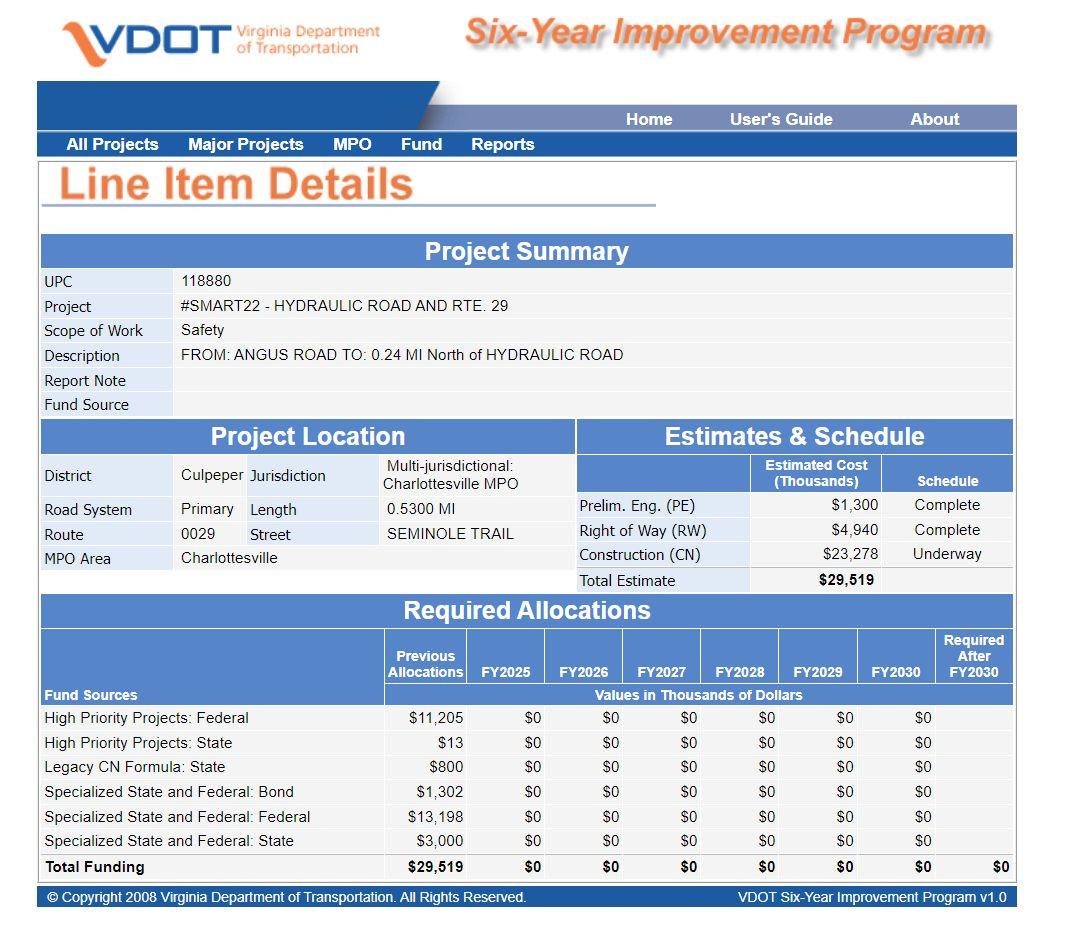
Fairfax County to get $50.6 million to replace buses with hybrids
While we’re on the topic of transportation funding, the new strategic plan now in place for Charlottesville Area Transit calls for the purchases of more buses to allow the city-operated bus system to run more frequently.
That document also calls for the purchase of both battery-electric vehicles and hydrogen fuel cell vehicles. One source of potential funding is the Federal Transit Authority and their low- and no-emission grants.
CAT did not apply for funding in the current cycle but will in the future, according to Director Garland Williams.
This week, the FTA announced the award of $1.5 billion to 117 public transportation projects in 47 states.
“Under the President’s historic Bipartisan Infrastructure Law, FTA has awarded nearly $5 billion in the past three years to replace and modernize transit buses on America’s roadways, building new technology with American workers,” reads a press release sent out on Tuesday. “U.S. factories will produce more than 4,600 of these new buses.”
Only one only locality or agency in the Commonwealth of Virginia had a successful application with the award of $50,591,220 to Fairfax County.
“The County of Fairfax, Virginia, will receive funding to buy new low emission diesel-electric hybrid buses to replace older buses as part of its fleet replacement plan,” reads a list of the awards.
The service there is called the Fairfax County Connector and that agency’s strategic plan calls for 36 such buses in FY25 and another 36 in FY26. The plan shows they’ll transition to purchasing electric buses beginning in FY27.
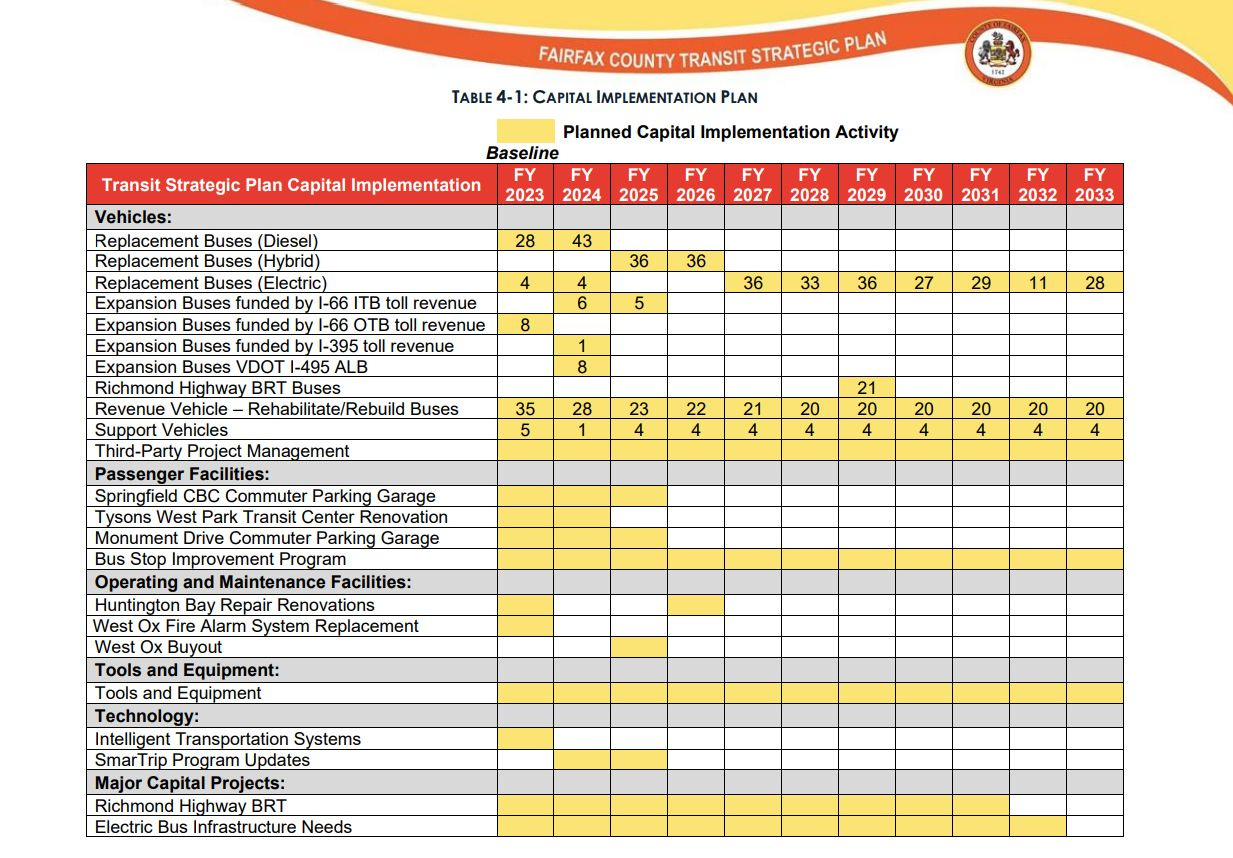
Reading material:
So Hoos Asking: There Is a Mystery Afoot at UVA. Where Is James Monroe?, Jane Kelly, UVA Today, July 2, 2024
CPD investigates fatal crash involving a vehicle and a pedestrian, Alexia Williams, CBS19 News, July 7, 2024
New Charlottesville Restaurants Bring Thai and Afghan Flavors to the Spotlight, Olivia Davis, Charlottesville Right Now, July 8, 2024
New Virginia-North Carolina intercity passenger rail line starts construction, Dan Zukowski, SmartCitiesDive, July 8, 2024
Fairfax Circuit Court finally makes case information available online for free, James Jarvis, FFXNow, July 8, 2024
Virginia Legislative Black Caucus expresses support for Biden’s continued candidacy, Charlotte Renee Woods, Virginia Mercury, July 8, 2024
Lynchburg city attorney, 2 council members clash at meeting, Matt Busse, Cardinal News, July 9, 2024
Emmet Street To Close for Bridge Removal, Matt Kelly, UVA Today, July 9, 2024
Charlottesville Police, Fire, and Transit Collective Bargaining Contracts all in effect, Maggie Glass, 29NBC WVIR, July 9, 2024
Farewell to #703
If this is called Charlottesville Community Engagement, why are there stories about other localities?
No one really asked that question, but I’m answering anyway. What happens in one locality in the Charlottesville area affects others. For instance, a lot of my power comes from the North Anna station. I was also curious this morning to inspect existing cell phone policies in the Thomas Jefferson Planning District.
I graduated from Virginia Tech with a political science degree because it was the closest thing that matched my curiosity about the world around me. Why do things happen? How do they get built? How can people understand the planning process that makes up bulk of the world we live in?
Right now, if you turn on a national television “news” program, there is likely only one or two stories. I don’t think that’s a way for people to understand how they are connected to a network of other humans. I write what I write to try to understand myself!
And now there are over 3,000 subscribers and a fifth of you are paying for them. It seems like I’m going to keep working on getting these out by 1 p.m. each day which allows me plenty of time to research. I’m both thrilled and grateful to be able to do this. Grate-thrilled? Let’s workshop that.
Anyway, now it’s time to get back to work on adding segments over to Information Charlottesville and to get some stories written for #704 and beyond.
You know the deal by now. Paid subscriptions are matched by Ting.
In return, I tell you that Ting can help you with your high speed Internet needs. If service is available in your area and you sign up for service, enter the promo code COMMUNITY and you will get:
Free installation
A second month for free
A $75 gift card to the Downtown Mall




